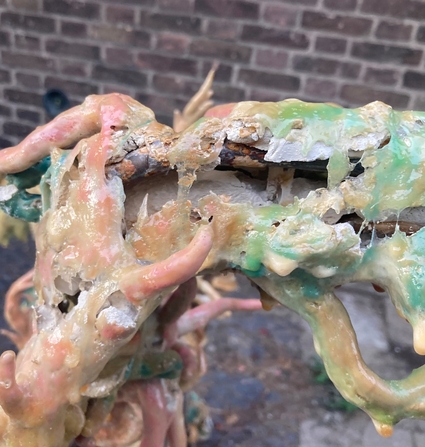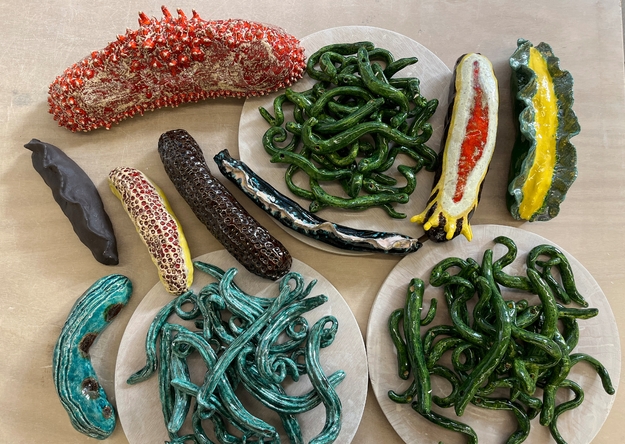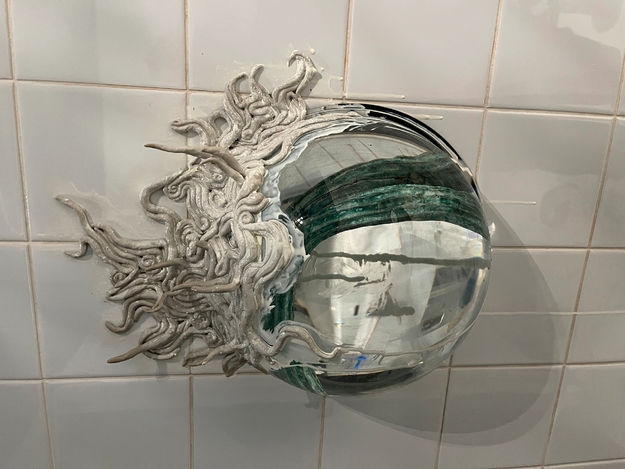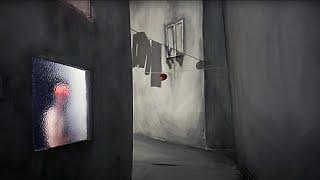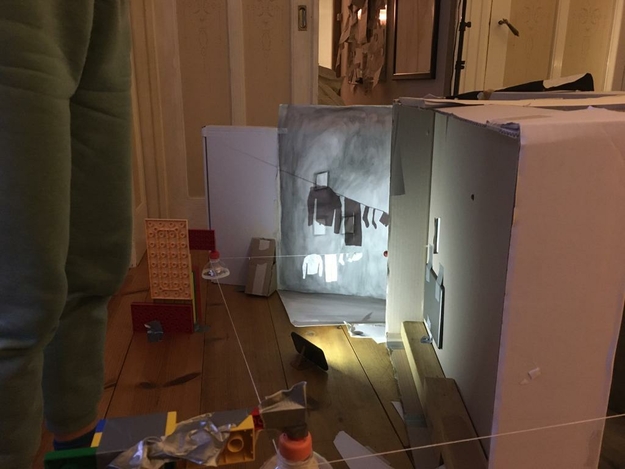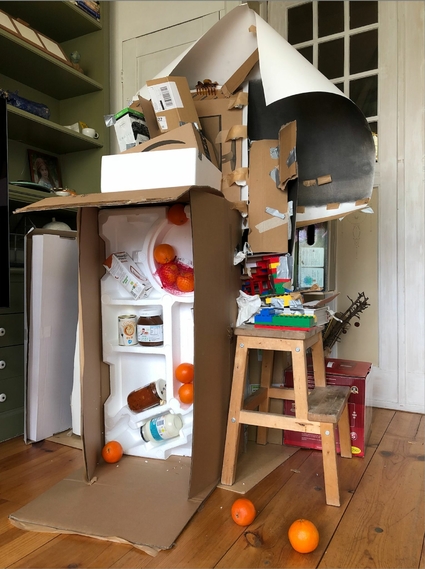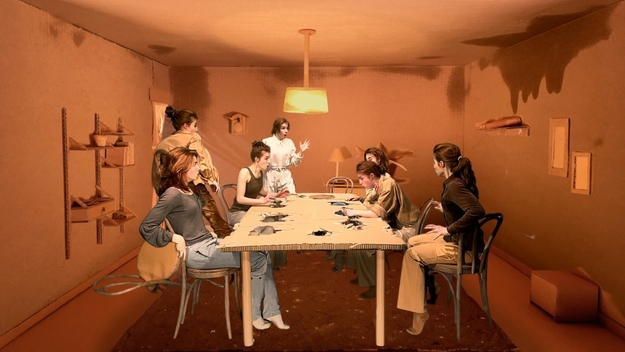Overview of the evening
First, Silke Riis introduced us to her artistic process, material technique and the bizarre and disturbing lives of sea cucumbers which inspired her installation 'Some breathe through their butts'. After the break, Jemima de Jonge shared the layered processes behind her films set in cardboard worlds, and the role of perfectionism in her practice.
Read on for a more detailed report!
Silke Riis: Some breathe through their butts
Mediamatic director Willem Velthoven introduced our first speaker: 'Silke will be here all year, transforming our toilets into the best toilets in all of the Dutch art world!'
With that, Silke took the stage an introduced herself: 'Hi, I’m 25 years old, from Copenhagen, but I’ve have lived in the Netherlands for the past four years. I studied at KABK in the Hague, in the Fine Arts department. Before I came to the Netherlands I worked as a florist, which is still an active part of my art practice, as you can probably tell if you went to the bathroom — I’m the maker of the installation Some breathe through their butts.'
Silke Riis during A/artist event - Photography: Romy Kerkman
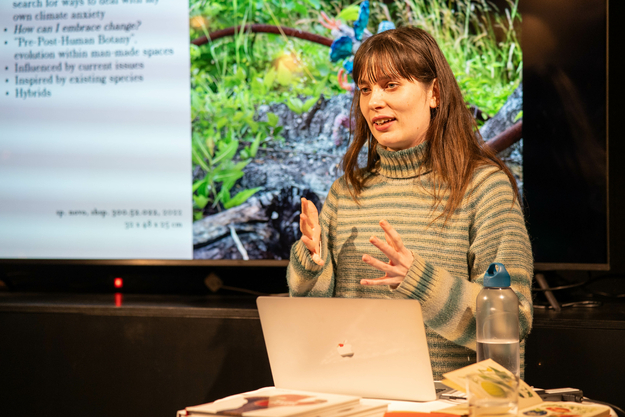
Speculative evolution
Silke continued by introducing her practice, and its guiding theme: speculative evolution, or the practice of imagining future species in a fantastical way. 'It’s typically seen in science fiction, also known as fictional biology or fictional zoology', she explained. 'My focus with my sculptures is usually on botanical species, but here at Mediamatic I evolved a bit and took inspiration from the animal kingdom as well.'
How can we embrace the change?
Working with speculative evolution, Silke shared, is a way for her to manage feelings of climate anxiety. 'As a maker of things, you are constantly face to face with materials so different from yourself, creating objects that will potentially outlive you', she mused. 'Approximately halfway through art school, I started having a really hard time with constantly producing so much and then throwing it away. It didn’t feel like my artistic practice aligned with the things I cared about personally.'
Reflecting on this conundrum and her climate anxiety in general, Silke concluded that it was related to a fear of change — 'in myself, in my surroundings and the people that I care about' — arriving at the question: How can I embrace the change?
'For me it really helped to find this tool from sci-fi, imagining what will come after myself', she shared. 'Even though it doesn’t necessarily come as utopian thoughts, I find a lot of peace in this practice. I think it’s calming to imagine a world without myself in it — I recommend it!'
Pre-posthuman botany
Silke’s voyages into speculative evolution take the form of sculptures. 'I’ve been working with them for two years now, and I named them pre-posthuman botany', she told us. 'It’s a bit of a joke, but also a nod to the typical idea of a posthuman as utopia — that all we need to do is remove humans and the earth will heal itself. I think it can be quite dangerous to think that way, because it eliminates humans from the context of ecosystems, while actually humans are part of nature and everything we create is also in essence natural in that way.' Following these ideas, Silke’s sculptures are meant to inhabit a future world shaped by climate change and inhabited by both humans and other species.
Suncatchers - Artwork by Silke Riis.
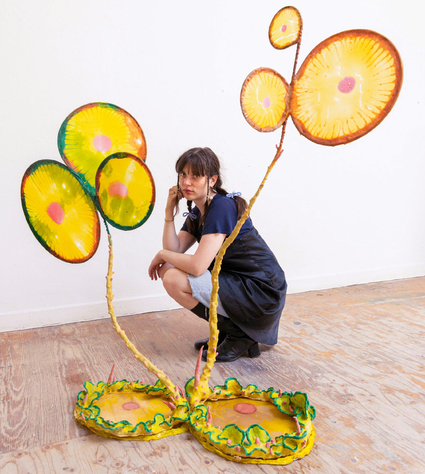
Root system of inspirations
'My inspiration comes from a lot of things', Silke continued: 'I normally describe my process as a root system that exists in my head, it’s very rhyzomatic, like mycelium'. Part of this root system are collections of old books of drawings of existing species, as well as movies, other artworks, conversations, and more.
'I discovered that I’m a think-while-making kind of artist. While working on a sculpture, I might all of a sudden remember this weird animal I saw when I was eight years old and google it… this adds a nice element of unreliability, because I’m not a scientist and very bad with names, so it already gets warped there.'
Dutchman’s potatoes
Building on these ideas, Silke mentioned another cornerstone of her practice: hybrid species.
'A good example is this sculpture I made last year, called Dutchman’s potatoes. For this piece I was inspired by this very endangered Amazonian species called Dutchman’s pipe, and then the common potato.' The two meld together into a being that represents pre-posthuman botany: 'One is highly endangered because of human actions, and the other is cultivated and its evolution changed because of human consumerism.', Silke explained. 'I like this duality.'
Claytex and decay
During her 'midlife art school crisis', Silke also began translating these thoughts into her very own material technique: Claytex, a combination of unfired clay and natural latex.
'Natural latex is the sap from rubber trees, it’s this white liquid that you can tap without killing the tree. It’s also called the tears of the trees, very poetic.', Silke explained.
Her practice consists of sculpting clay around metal, ceramic or wood structures, then glazing the clay with natural latex. 'I like to think of the structures as the bones or skeleton of my sculptures, putting on the hat of a future archeologist and thinking of what will be left behind at the end of the life of this sculpture.', she elaborated.
The end of life, and the process of decay preceding it, are very important parts of the sculptures’ existence. 'This combination of materials creates a very alive, but also dying material.', Silke told us. 'It’s alive in the sense that in the clay, because it’s wet, there’s room for mold to grow, and the latex when it’s wet is like nectar for insects, they really dig it.' She continued: 'But it’s also in the process of dying, like when you pick a flower and it turns brown. That’s exactly what happens to the natural latex over time. It’s influenced by many outside factors such as temperature, humidity and touch. I view it as a kind of modern vanitas symbol, a reminder of mortality, tying it back to myself dealing with my own mortality and fear of change.'
Silke used the same technique to create her installation in two of the Mediamatic bathrooms. 'I sculpt the shapes that I want with the clay while it’s wet, and then I start applying the natural latex', she explained — 'It takes forever, because one layer alone takes hours to dry, and I do at least ten layers for it to stay. This way, the wet clay gets completely encapsulated by the latex, so it takes a long time to dry, and in this time the colour of the clay changes. At the same time, the latex dries around it and remembers the exact shape of the clay. When clay is dried but not baked, it gets very porous. So once the latex is dry, you can touch the tentacles, breaking the clay inside and making them more bendable that way.', she explained the tactile aspect of her work: 'You can go and try it later, the more you touch it, the more you break the clay and the more you make it porous. For my installation here, I will continue to add more and more pieces on the walls throughout the year, so there will be different stages of the decomposition process.'
Silke Riis producing her installation work "Some Breathe Through Their Butts" -
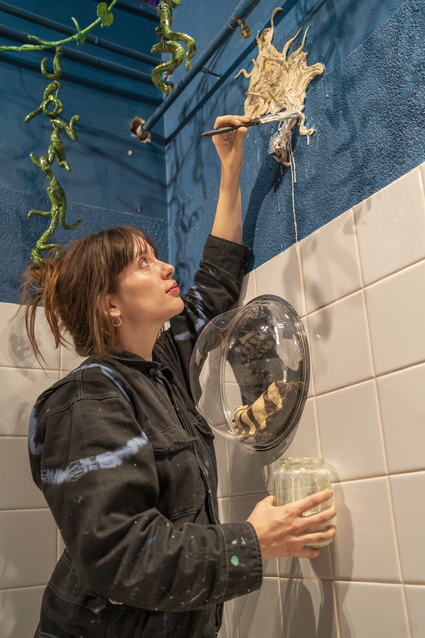
The claytex technique is also partially circular: 'I can reharvest the clay, rehydrate and reuse it, so there’s a little bit of sustainability there'.
Museum night: cucumber craze
The installation in the Mediamatic bathrooms came about as part of the 2023 museum night programme, Self, which revolved around questions of the mind, and what is and isn’t considered “normal“. Silke shared the thought process leading to her museum night contribution in the form of an email she wrote to a/Artist co-curator Annelies Wina Doom, entitled 'Bathroom installation: Cucumber craze':
'Hi Annelies.
As you can probably tell from this, I have become completely obsessed with the idea of a habitat/jungle for a hybrid of sea cucumbers and plate cucumbers. The idea started with me flipping through some of my plant books […]. Here, I quickly stumbled over the cucumber and remembered the EU law from the 80s about the shape of cucumbers. They can not be bent but have to be cultivated straight. I already thought this was a funny connection to the museum night theme, […] creating a normal that is actually not normal at all for this species. I then remembered the English name for one of the weirdest and probably grossest, least beloved sea creatures: sea cucumber. Their leathery skin immediately reminded me of latex, and I saw endless possibilities of making variations of both sea and plate cucumbers. The most normal food vegetable, which actually comes in many abnormal shapes and sizes, and the most easygoing sea creature coming together in their bathroom habitat. Then another funny thing hit me as I was making the first clay sketch: […] The cucumber shape is very poop-like, and when you poop in a toilet, what is left is the shape of a brown sea cucumber at the bottom of the toilet ocean. Make your own sea cucumbers, haha! In Danish, sea cucumber is actually called sea sausage or sea poop.'
The bizarre and disturbing life of sea cucumbers
Silke shared images of her initial cucumber-sea cucumber hybrid sketches, saying: 'My main idea was that of a hybrid habitat, for plants and sea creatures alike. Potentially Amsterdam will be deep sea in twenty years, let’s embrace it.' However, the idea evolved as Silke dug deeper into researching the sea cucumber. 'The more I learned, the more I fell in love with them. The sea cucumber is quite a humble animal, they do nothing but eat and poop all day. But this process of eating and pooping is actually a really crucial part of the ecosystem they are part of, because when they do it they filter through the sediment and release a lot of different nutrients. One of these is nitrogen which is important for the nitrogen cycle, both corals and algae also use it.' Happily, she pointed out that algae have also started growing in her bathroom installation.
Some Breathe Through Their Butts - Sculpture by Silke Riis.
Photography: Romy Kerkman
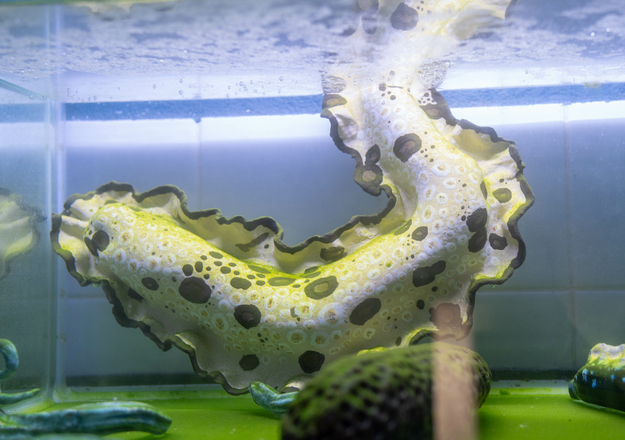
She continued: 'They also release calcium carbonate, which is especially important for the exoskeletons of corals, but there is less of it in the oceans now due to ocean acidification, which is a direct consequence of global warming.'
Sea cucumbers, therefore, have been called 'the unsung heroes of the ocean'. 'I wanted to really give them the stage they deserve and honour that.', Silke said. 'So in the end I decided to only put the sea cucumbers’ poop patterns on the wall, to really put a spotlight on this honourable act that they do.' She also showed us excerpts from an article by Justine E. Hausheer, entitled 'The bizarre and disturbing life of sea cucumbers'. Silke’s favourite fact about sea cucumbers, revealed in this article, became the title of the installation: they breathe through their butts. 'This is a fact, all variants of sea cucumbers breathe through their anus. I thought that was amazing, I’ve never heard of an animal doing that before.', Silke gushed. 'And I immediately thought about how when you go to the toilet, you expose your butt — I thought this is a nice way to connect with this animal: for a moment, when you are in the bathroom, you also get air to your butt, and can maybe relate a bit more to this creature.'
She ended her talk by encouraging the audience to visit the installation, and return to it over the coming months to witness its changes: 'I encourage you to go and breathe through your butt for a moment!'
Q&A with Silke
'Do you ever find yourself looking too far ahead, trying to visualise what your sculptures will look like in a year, or are you happy to just leave it to the universe?', a/Artist colleague Fern asked.
'I’m definitely struggling a lot with that', Silke replied — 'letting go of this control. When the pieces are resting in my studio space and they’re falling apart, and I have to stop myself from fixing them. It’s such a big part of my concept to allow them to fall apart but I still think oh, but it’s my baby! But if you love it, let it go, I guess? I try to think ahead, but it also surprises me a lot, it’s a bit unpredictable. I’ve also only worked with it for two years, so I don’t know what it looks like in twenty years yet.'
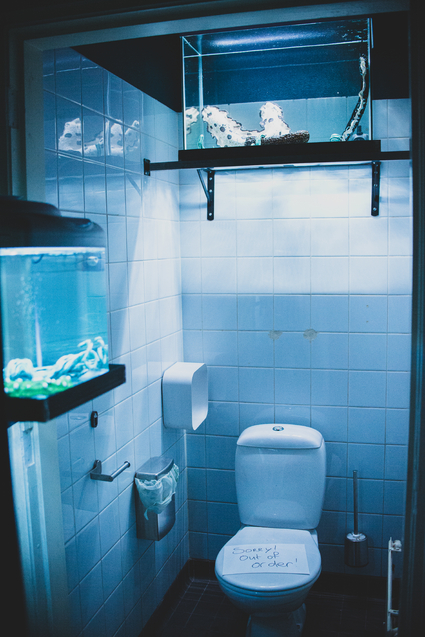
Another guest asked: 'Do you know where your first sculpture is? And can you revisit that one?'
'Yes!', Silke said — 'The very first tryout is lost somewhere in Vienna, but the second one I still have in my studio. It’s holding on for dear life, there’s mainly just the spine left on it. For me there’s a lot of liberation in this idea that they will not last forever, that I don’t have to store them forever but I also don’t have to worry.'
'Where do you source your clay?', someone else wanted to know. 'I want to be the kind of person who sources her own clay', Silke admitted, 'but right now it’s just what my money can buy me. But in April I’ll go to this small island in Denmark where my family is from and source clay there and learn to work with naturally sourced clay. There’s something really nice about working with locally sourced material, so that’s definitely a next step.'
Co-curator Annelies asked: 'Do you think touching your own sculptures is healing for you in a way, do you enjoy touching them?'
'For sure', Silke replied. 'This is an assumption, but I think that this applies to everyone who makes something — you’re so in touch with it while making it, and I always thought with painting especially it’s such a shame that you don’t usually touch the canvas, because you touch it while making it and it’s just a different experience. I’m the kind of person who always secretly touches artworks, so I also hope that likeminded people, when they lock the door and are completely alone with my work, will explore it with their hands.'
Jemima de Jonge: Table Scene from A Body Of Water
After the break, our second presenter Jemima de Jonge took the stage. She began by showing us a still image from her installation A Body of Water — Table scene, on display at Mediamatic since the 2023 museum night. The table scene constitutes only one part of this larger work, which visually reflects spaces filling with water and drying up again, like a breathing body.
Jemima de Jonge at A/artist event - Photography: Romy Kerkman
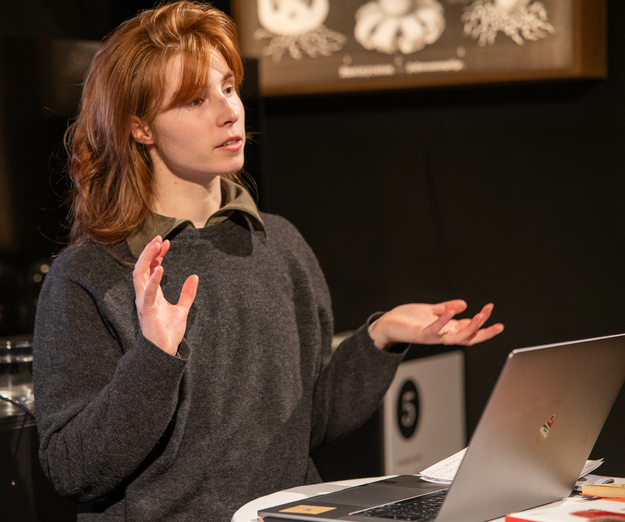
'Using architectural forms is very important, because you really become part of it — Bowing your head and going under something to enter the space, really getting a feeling of the physicality of the spaces. So I encourage you to go see the work and experience it later!', Jemima explained.
She also pointed to the recurring theme of perfectionism in her work and practice. 'It’s an important topic in the context of neurodivergence and making art, because it loses some human touch if you strive for perfection. I’ll talk more about how I deal with this in my own practice and how I create a sort of barrier in order to have a free working space.'
Detailed cardboard sets
Showing examples from her graduation project, also a film staged in a setting modelled from cardboard, Jemima’s current material of choice, she reflected on the importance of scale in her practice. 'It’s something very intimate, but at the same time looking out at a bigger whole — the feeling of in-between is very important in my work.'
For her films, Jemima creates detailed maquettes (small preliminary models) out of cardboard and paper. 'This material is really forcing me to sometimes embrace the imperfection, but at the same time I really want them to be detailed. The first time I started working with cardboard I completely lost myself in making them. I started using cardboard because I wanted to have a more plain background for a film I made, where you travel through different spaces and look through a window. It was supposed to be about what’s happening behind the window, but in the end the attention was way more on what was happening in the space, because of the detail of the cardboard. It’s a very meditative thing for me to do, unless there’s time pressure — then it’s a very stressful thing.'
A Body of Water cardboard set -
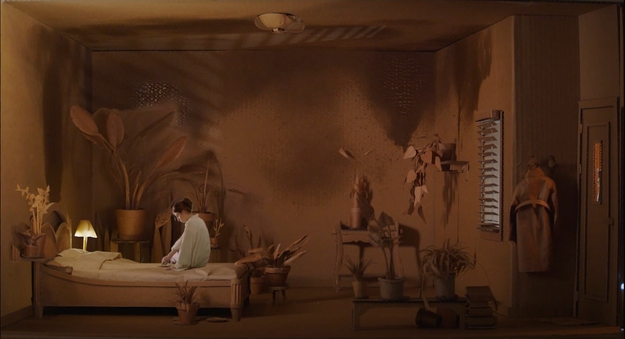
Creative control
Jemima shared how, throughout her creative process, she takes on many different roles. 'I make the maquettes and use them as set pieces where I have full control over the lighting and the POVs. Then I work with green screens in the studio where I act out the different characters, and add them into the spaces afterwards.'
'This feeling of wanting to control every single step of the process is something I need to learn to let go of', she admitted. At the same time, she acknowledged that control is what she appreciates about this medium: 'That’s the beauty of filmmaking, I think — that you work with a script, you need to plan it out, there’s a limited budget and therefore limited time to film, and everybody needs to be there at the right time in the right moment.'
Jemima de Jonge filming for 'A Body of Water' -
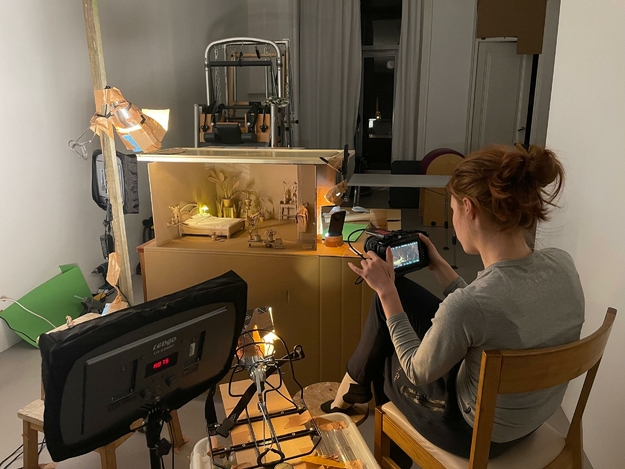
Table scene: compulsion, tragedy, and humour
Jemima told us about one of the the inspirations behind her Table Scene: An American documentary about pica, an eating disorder in which people eat things that are not usually considered food — 'such as car parts or air freshener, or drinking gasoline…'
'The way people were portrayed in these episodes was so absurd to me — it’s very sensational television, for example these very dynamic shots of a woman hiding cans of air freshener around the house…at the same time all these stories have a flip side, there’s always a reason and a painful story behind why someone has an addiction or compulsive behaviour.'
'Uitspuigen' from Table Scene: A Body of Water -
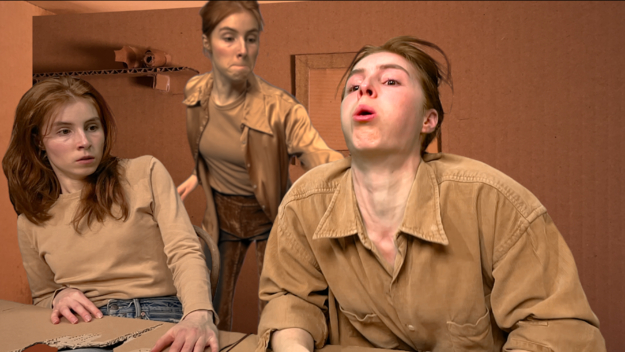
It is this contrast which Jemima also seeks out in her own work: 'The tipping point where two emotions meet, where humour and pain collide…another example is the contrast between claustrophobia and the feeling of being embraced.'
'I don’t want to mimic the documentary', she clarified. 'But it’s about the aspect of eating away your environment, almost like an insect, being underground and encapsulated in a body.'
She also showed images of the studio where she recorded the sound for the film: 'You can see loads of cardboard that I had to eat and spit out over and over in order to get the exact right sound…'
Recording sound for 'Table Scene' -
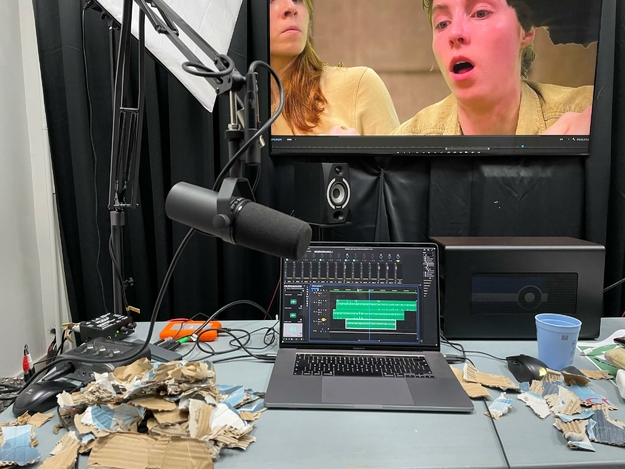
Uprooted
Jemima then showed an excerpt from her first short film, Uprooted, which she created during her second year of art school, in order to show her evolution in style and working process.
The camera inches through a cardboard set of narrow, grey alleys, we see shadows of clothes lines and windows that are actually screens, underlaid with discordant bell sounds. The camera’s movement gives the impression of being in a scary 1st person POV video game, with the music and the claustrophobic setting all adding to a sense of unease. A real clothesline appears in view but the way to it is obstructed by a heap of things, the camera follows the clothesline to a red door, which transforms into a tunnel-like thicket of human hair, we hear voices, a milky window appears and someone thumps against it from the other side but we retreat to hide in the hair again…
At this point, Jemima stops the video. 'I’m not sure if you can see, but it was kind of ambitious to try something like this in the second year of art school.', she said. 'I kind of lost myself in then process, I’m not sure if it was healthy… I think part of that also added to the feeling in the film.'
Again, she came back to perfectionism: 'There’s this weird contrast where I throw myself into doing things I’ve never done before but I still want to do them perfectly. But I do this on purpose, because I know that in the end I’l never be able to make things perfectly. So this helps me to keep going and not stagnate, to also play and learn to play.'
Dreams and discovery
Creating the maquettes for the set of this film, Jemima emphasised the importance of dreams in her process: 'First I dream, and this stage of dreaming is extremely important before I idealise things. I was trying things out to see how my emotions could take place in a physical space. Because I was so into it, I started dreaming about walking in the city, about turning a corner where something would happen and that’s how the film developed, scene per scene.'
She reflected on the importance of integrating a feeling of discovery into both the process and the work itself: 'This nomadic way of working was really special to me, and it’s something I want to give to the audience, too: like you’re a child wandering in the forest and finding a little box and opening it, I’d love to trigger this kind of curiosity in people.'
D.I.Y.
Jemima also showed us a number of behind the scenes photos of how she staged her films, often finding creative DIY solutions: 'I just taped an iPad to the cardboard and used things I had on hand… I’ve become a bit more high-tech now but I still force myself to use as minimal things as possible. You see that in the end result, there’s this almost cultivated naiveness to it.'
For the table scene, she used a small light with a lens taped to a piece of cardboard to create a spotlight. 'It’s really simple, but the technicality really makes it joyful for me.'
She also remarked on enacting different characters in front of the green screen: 'Stepping into a character separates me from my critical self, because when you act, you can not also be in the director’s chair at the same time.'
Jemima ended with a wish to open up her creative process to more people: 'I would love to share these layers of the process with others, to create more of a setting where we can all play.'
Q&A with Jemima
Silke asked: 'You mentioned how you were craving to share your process with others, and yet in this work you have nine characters all played by yourself. Can you elaborate a bit on that choice?'
Jemima replied: 'It’s an inner dialogue. It’s about different ways we all respond to a situation like this in our primal form, the fight or flight response — different people respond in different ways, it can also be a conflict within yourself. You can see the differences more clearly when it’s the same person.'
'What is it like to see your own work, being a perfectionist like that?', another guest wanted to know.
'This is why deadlines are fantastic', Jemima reflected — 'you can’t control when the work will be on display. Although I still work over-hours to get it to the point I want it to be… for this film I worked on it for so long that it became totally alienated, I’ve seen it so many times that I can dream it. It’s not even like looking at myself anymore.'
She added: 'I also learned to accept that there is value in it that I won’t see, but other people will. Because some things are rough, the details stand out more. I think it’s really nice that you can see the hand of the maker in the work even though it’s video — when working with clay, you can see fingerprints, and I strive for this kind of fingerprint, this tactility, with video works as well.'
Someone else noticed Jemima’s recurrent mention of dreams and dreaming: 'Is this really a part of your process, like lucid dreaming, or is it another way of saying you imagined something?'
'I think it’s important inspiration.', she replied. 'And it’s a good way to measure how I feel about things. There’s some stigma around using dreaming as inspiration in art school, so I’ve stayed away from referencing it a lot but it’s also strange not to mention it because it plays such a big role. It’s a bit frowned upon.. but it will come back.'
'What are you currently working on?', another guest wanted to know.
In response, Jemima addressed the reality of working as an artist: 'I’m dying to work on something new, but because I had the chance to show my work in many different places I’ve had to organise and plan and learn how to be an artist — it’s 50% being a manager, which is really important, but I also want to find the time to dive into the process of making something and not knowing where it leads. Right now, I’m working now on a project about my family history and what I’d love to do is just be there, observe, draw, document things, talk to people, and build the story from there. This is is a process that works for me, but it’s something you have to plan in: not having an outcome immediately. It can be really frustrating not to know where something is leading, but this uncertainty is also a drive for me.'
Original event information
Tickets (inc. vegan meal + drink):
Student/artist/Stadpas: €9.80
Full price: €14.00
The event will be hosted by the A/artist program team, a project at Mediamatic which platforms artists and designers who identify as/with the ASD or ADD spectrums. The program started in 2021, focusing on hosting regular roundtable sessions and publishing articles generated through these discussions.
These a/Artist events on neurodiversity in the arts are held every third Monday of the month. We organise an evening with presentations by two artists, a good conversation and something to eat (included in the ticket).
If you have any questions, please feel free to contact a.artist@mediamatic.nl!
Read more about the a/Artist meetings in this article in Autisme Magazine (Dutch).

